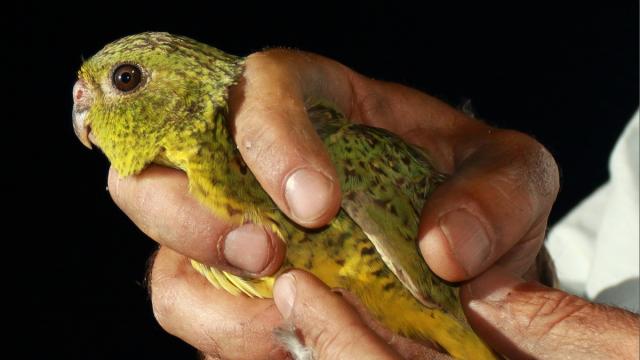Little is known about Australia’s mysterious night parrot but researchers now believe they’ve uncovered a pretty big fact — it might actually have terrible night vision.
Researchers from the University of Queensland and other universities internationally have uncovered some fascinating facts about the elusive night parrot, publishing the findings in Scientific Reports in June.
The night parrot inhabits arid areas of south-west Queensland and northern inland Western Australia but sightings are so rare, it was thought to be extinct for most of the 20th century until a population was rediscovered in 2013.
[related_content first=”1222114″]
This means our understanding of the green-coloured parrot is limited and studying it is particularly challenging for researchers. It was given the moniker night parrot because of its tendency to hide in the day and come out for food in the night unlike other known parrot species.
A night parrot with no night vision
The new research paper has found that despite its preference for the dark, the night parrot hasn’t developed its night vision any better than other parrots. In fact, it often bumps into obstacles in the outback, like fences.
“Night parrots must be able to find their way at night — to find food, avoid obstacles while flying and escape predators,” Dr Vera Weisbecker, one of the paper’s researchers, said in a media release.
“We therefore expect their visual system to show adaptations for seeing in the dark, similar to other nocturnal birds – frogmouths and owls with enlarged eyes for example.
“However, we found that this wasn’t the case.”
Through scans of the parrot’s skull and 3D reconstructions of its brain, researchers compared it to that of similar, more common parrot species. It found they shared similar eye sizes but ultimately, the night parrot had smaller optic nerves and an optic lobe.
“This suggests that the night parrot may not be great at seeing in the dark – its vision is likely sensitive but with poor resolution, so that it might not be good at distinguishing obstacles like wire fences or even predators in dark conditions,” Aubrey Keirnan, a co-author on the paper, said.
Fencing could be hurting the species’ chances at survival
The parrot’s inability to see well in the dark presents a major problem. Rural and outback areas of Queensland and Western Australia are filled with fences to shelter livestock and keep out predators.
But the findings show they could also be inadvertently affecting the bird’s chances at escaping dangerous situations.
“The results of the study suggest that removal of unused fences should be a priority in areas where night parrots are known to occur,” Dr Weisbecker said.
“However, we probably can’t go entirely without fences — stock needs to be managed with fences, and some forms of predator exclusion could be important for protecting the night parrot.
“We therefore need to be very careful with our fencing strategies, at least by increasing the visibility of wire fences, but alternatives such as low-tension electric fencing could be even better.”
With so few sightings of the bird in the real world, it’s hard to tell how much it population levels are truly affected. In the meantime, however, these sorts of strategies can work to minimise further impact humans have on their survival.
[related_content first=”1202776″]
